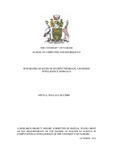| dc.contributor.author | Kinyua, Wallace M | |
| dc.date.accessioned | 2016-11-16T09:23:58Z | |
| dc.date.available | 2016-11-16T09:23:58Z | |
| dc.date.issued | 2016-10 | |
| dc.identifier.uri | http://hdl.handle.net/11295/97431 | |
| dc.description.abstract | Over the years the negative notion that people have held about feedback is quickly changing and now more than ever we are using our customer feedback as a way to assess our current market placement and improve our services. Institutions of higher learning are on the influx in Kenya since the promulgation of the new constitution and also as a result of the demand.
In view of this, there is a need to differentiate oneself in terms of the value that you can offer to your students not only in terms of your faculty and lowered prices but also by listening to your students as a way of assessing your organization and taking steps in the positive direction to improve any areas that may be found waiting.
Currently many universities collect feedback from their students however this feedback once collected is either saved somewhere in a document or on online solutions that are singular in their nature of analysis. There are some universities (almost all surveyed are not from Africa) who actually have functioning feedback systems which they use in collection of data from their participants, the nature of analytics composed in these systems are however not open to the general public.
The aim of this research was to identify the key processes that constitute an optimal feedback process with a keen focus on educational institutions and thereafter implement an integrated (holistic) analysis tool that allows capture and analysis of student feedback efficiently with the overall aim of improving the service given to students by aiding decision making based on the reports given.
The output of this research has been the successful implementation of the integrated feedback analysis system at SBS with the successfully incorporation of the historical feedback that existed prior to make visible trends that were earlier unknown. It was established that the system could serve as an aid to the decision making process due to the fact that the top management rated the system very well and through the reports they could quickly identify gaps in terms of information that could be catered for by the reports given by the system such as making decisions based on the performance of the persons or departments in question as informed by the trend. Furthermore, it was clear that the use of online feedback system increased the efficiency of the administrator responsible for the dissemination of feedback since it significantly reduced the time spent on the preparation and distribution of the forms to the students plus the other manual tasks involved in the entire process. Finally, the system ratings were commendable thus signaling the high likelihood of full adoption in the feedback ecosystem of the strathmore business school and the possible implementations to other institutions of higher learning. | en_US |
| dc.language.iso | en | en_US |
| dc.publisher | University of Nairobi | en_US |
| dc.rights | Attribution-NonCommercial-NoDerivs 3.0 United States | * |
| dc.rights.uri | http://creativecommons.org/licenses/by-nc-nd/3.0/us/ | * |
| dc.title | Integrated Analysis Of Student Feedback, A Business Integrated Intelligence Approach | en_US |
| dc.type | Thesis | en_US |



